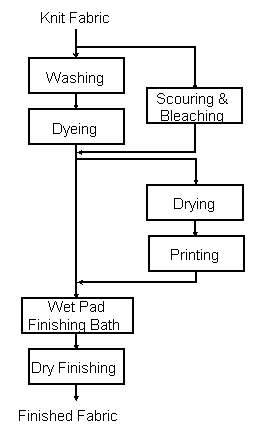The knit fabric industry is characterized by a large number of plants and organized structure, including specialized products segments such as knit fabric goods, hosiery, outerwear and underwear. This category is characterized by operating units such as bleaching, dyeing, printing, resin treatment, water proofing, flame proofing, and the application of soil repellency or special finishes. The wet processing operations performed in knit fabric finishing are shown schematically in Figure 6. This is only a generalized flow sheet, as the specific operations employed in a given facility will vary from plant to plant. In general, yarns are purchased in the undyed state, with a knitting oil finish to provide lubrication for the knitting operation. Lubricants (knitting oils) that can be applied to knitting yarns include mineral oil, vegetable oil, synthetic ester-type oil or waxes. These lubricants may also contain anti-static agents, antioxidants, bacteriostat and corrosion inhibitors. The amount of oil applied varies with the type of yarns. Knitting oils are also injected into the needles of knitting machines in order to lubricate and lower the temperature of the needles. The knitting oil present in knit greige goods is readily emulsified or soluble in water and is scoured or washed out as an effluent. After the yarn has been knitted into fabric, the fabric may be processed by one or more of the alternative routes indicated in figure 6.
The main difference between woven and knit fabric finishing is that the desizing operation is not required for the knit so the generation of effluent load is relatively low. Here the knit yarn is treated with lubricants rather than with the starch or polymeric sizes used for woven goods [10].
